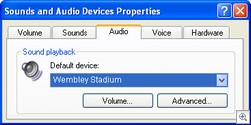9 Jan, 2008
 Many TV stations lift the volume of their ads to ridiculous levels. I wouldn’t mind ads if they were the same volume as the movie, but the stations have taken it too far, requiring watchers to fiddle with their remotes each time an ad break comes along.
Many TV stations lift the volume of their ads to ridiculous levels. I wouldn’t mind ads if they were the same volume as the movie, but the stations have taken it too far, requiring watchers to fiddle with their remotes each time an ad break comes along.
If you have a Digital Video Recorder or Home Theatre PC, you may like to consider removing the ads from your recorded shows. This will save you time when you watch old recordings, and save you from the volume hikes.
I have played with a number of ad removal programs in the past, with limited to no success. It is not an easy task for any programmer to write software which will remove ads flawlessly. For it to be done well, it should look like it was easy.
Lifextender is a program which will remove ads from your recordings. I was sceptical when I first downloaded it, but then after recording a few shows and running Lifextender over them, I was really impressed. It worked! There was no manual work or switching between programs required. It looked after it all.
Lifextender sits in the tasktray or can be run manually. You can set it to scan your recorded shows at set times of the day or it can process them once the recording is complete. There are a whole heap of options available to you, but the default settings will suit most needs. I can’t understand why it is still in alpha phase of development. I came across no problems.
Lifextender can run as a Media Center plugin or as a stand-alone application. I have set it to run at 2:00am in the morning so that the processing doesn’t interfere with my general computer use.
Lifextender is available for free from cnet or Lifextender.com.
3 Jan, 2008
 There once was a time that we had to use a PC speaker to hear sound effects in games. Some games even offered small digitised voice effects, which we were impressed with at the time. The next stage was adlib soundcards which could handle midi sounds. They were still fairly weak, but they were a huge improvement on what we were once used to.
There once was a time that we had to use a PC speaker to hear sound effects in games. Some games even offered small digitised voice effects, which we were impressed with at the time. The next stage was adlib soundcards which could handle midi sounds. They were still fairly weak, but they were a huge improvement on what we were once used to.
Since that time, soundcards have evolved into a very important feature in any computer. The sound quality which comes out of even the cheapest cards is good enough to listen to music or to watch a movie. Why not take full advantage of this technology and hook it up to your sound system to get your MP3’s pumping.
Current PC speakers on the market sound quite good, but they will never be able to recreate the awesome sound you can get out of your main sound system. It shouldn’t cost you more than a few dollars to setup. Even if you don’t want to set this up for permanent use, it is worth keeping in mind for parties as it will be appreciated by your guests. I haven’t bothered with PC speakers for years as it is easier for me to connect my computer to my sound system.
This article will show you how to connect your computers soundcard to your sound system. I have already written an article explaining “How-to: Connect your PC to your television and stereo”, but I placed a large emphasis on the video side of things and many of the comments are related to audio. This article will only cover audio. I hope you will be amazed how easy it is.
Read the rest of this entry »
19 Dec, 2007
Difficulty Rating:

Have you ever noticed that when you get started on a particular task on your computer, you always open up the same bundle of programs to do it? Why not make it easier for yourself and get all of these programs loading up when you want them, with a single click. The answer is batch files.
Batch files have been around longer than Windows has, but sadly they have been forgotten over the years. Generally, DOS is not a nice environment to work in compared to the graphical operating systems we have these days. I feel batch files still have their place. They are very simple to create and they can be edited easily.
You may have already set up your computer to automatically launch particular programs as part of your computers start up sequence. While this will work, it is not really the ideal situation, because you may not be ready to use the programs straight away. This can slightly slow you down or clutter your workspace, for no good reason. Instead, if you use batch files, your specified programs will launch simultaneously with one click, only when you’re ready to use them.
In this article we will look at how to create some basic batch files which you can alter to suit your own needs. For this How-to article, I am going to use batch files to launch environments, e.g. turning your computer into a multimedia heaven.
Read the rest of this entry »
17 Dec, 2007
 POP email servers are not as smart as IMAP, Exchange or online email services. They are unable to keep track of what mail you have already downloaded, when you are moving between computers or when you have just reinstalled Outlook (if you have imported a backup). This is not normally a problem in day to day use, but when you do make changes to your email account settings, you can end up with duplicate items, and a lot of them.
POP email servers are not as smart as IMAP, Exchange or online email services. They are unable to keep track of what mail you have already downloaded, when you are moving between computers or when you have just reinstalled Outlook (if you have imported a backup). This is not normally a problem in day to day use, but when you do make changes to your email account settings, you can end up with duplicate items, and a lot of them.
It is a real hassle to remove each of these duplicate items individually, and in the past I have manually removed them. Today after a fresh install of Outlook, I had around 150 duplicate items! I needed to find a better way to automate the removal of these. I came across a number of utilities that would do the job. Some of them are free and others are commercial or shareware releases. After a bit of testing Outlook Duplicate Items Remover (ODIR) came out on top.
ODIR scans your Outlook mail, contacts, tasks and calendar for duplicate items. If an item is found to be a duplicate it moves the item into a folder called ODIR Duplicate Items. You can then look through this folder and then delete it’s contents once you are comfortable that you don’t need any of them.
There are a number of reasons I preferred ODIR over the other utilities I tested out. First of all, it is free which is always a big selling point for me. ODIR had fewer options than many of the others, but in the end I felt most comfortable using it as it did not automatically delete duplicate items (as most of the others did). Instead, ODIR moved them into a separate directory which I could quickly sift through to confirm that no legitimate mail was removed.
If you find yourself in the same situation, do yourself a favour and download ODIR. It is so quick and easy to use, making this huge hassle a piece of cake.
ODIR is available for free from Vaita. Tested on Outlook 2007 in Vista.
11 Dec, 2007
 It’s not very often I post about a single piece of software twice. In fact, this is the first time. A recent update now makes WindowsPager much more stable and functional than previous versions.
It’s not very often I post about a single piece of software twice. In fact, this is the first time. A recent update now makes WindowsPager much more stable and functional than previous versions.
In Linux there is (and has been for as long as I can remember), a feature in which you can have multiple desktops/workspaces that you can switch between. This is ideal for organising your running programs. I like using workspaces so that I can have one workspace for work, and another few for play. It also makes for a great boss key.
WindowsPager is an evolving project hosted at SourceForge which has come a long way in a short time. It looks the same as the Linux switcher sitting snuggly in your taskbar, and it is just as easy to use. To switch workspaces, click on the workspace you want to go to. To move an application from one workspace to another, hold down ctrl and drag the icon of it to the desired workspace. A new additional feature in this version lets you click in the titlebar of any window and “move to” any other desktop.
WindowsPager has been working well for me since version 0.8. WindowsPager 0.21 has just been released and is a big improvement. We can look forward to added functionality and stability in future releases. I am finding that in its current state, WindowsPager looks and works much better than any other workspace switchers I could find for Windows.
There are a couple of limitations. You cannot drag a window from one workspace to another using the title bar. Saying that, I have not come across a Windows workspace switcher that can do this. There is also no dual screen support. It does work with dual screens, but only the preferred screen will be shown. All the releases are currently alpha releases, so bugs are to be expected though I have not come across any bugs in the current version after a week of use.
To have WindowsPager load at startup, create a shortcut to it in the startup folder of your start menu.
I am very excited about this project and I am going to continue tracking it as it is developed. Get your copy for free from SourceForge.
 Many TV stations lift the volume of their ads to ridiculous levels. I wouldn’t mind ads if they were the same volume as the movie, but the stations have taken it too far, requiring watchers to fiddle with their remotes each time an ad break comes along.
Many TV stations lift the volume of their ads to ridiculous levels. I wouldn’t mind ads if they were the same volume as the movie, but the stations have taken it too far, requiring watchers to fiddle with their remotes each time an ad break comes along.



 It’s not very often I post about a single piece of software twice. In fact, this is the first time. A recent update now makes WindowsPager much more stable and functional than previous versions.
It’s not very often I post about a single piece of software twice. In fact, this is the first time. A recent update now makes WindowsPager much more stable and functional than previous versions.